-
TrackoBit
Manage commercial vehicles with the new-age Fleet Management Software
TrackoBit -
TrackoField
Streamline your scattered workforce with Field Force Management Software
TrackoField -
Features Resources
-
Blog
Carefully curated articles to update you on industrial trends. -
White Paper
Insightful papers and analysis on essential subject matters. -
Glossary
Explore an alphabetical list of relevant industry terms. -
What’s New
Get TrackoBit & TrackoField monthly updates here. -
Case Study
Explore the cases we solved with our diverse solutions. -
Comparisons
Compare platforms, features, and pricing to find your best fit.
-
About Us
Get to know TrackoBit: our team, ethos, values, and vision. -
Careers
Join the most dynamic cult of coders, creatives and changemakers. -
Tech Support
Learn about our technical support team and services in detail. -
Events
Check out the exhibitions where we left our marks and conquered. -
Contact Us
Connect with us and let us know how we can be of service.
What is Absenteeism? Its Effects and Consequences (How TrackoField Beats It)
- Author:Shivani Singh
- Read Time:15 min
- Published:
- Last Update: October 9, 2025
Table of Contents
Toggle
Discover what is absenteeism, its causes, and its effects on operational productivity. Read tips that actually reduce it.
Table of Contents
Toggle
Employees take leave from work for a variety of reasons. However, when those leaves are too often, it leads to habitual absences. This phenomenon is termed absenteeism and can impact the overall field job scheduling process, resulting in a shortage of staff, delayed orders, or cancelled appointments.
But if addressed, strategically, it can become a serious issue for businesses. So, before it gets out of hand, try to assess the main reasons behind employees’ absenteeism.
You can adopt proactive field force management solutions that let you analyse attendance trends and alter your leave policies accordingly. This way, you will not only reduce the effects of absenteeism on your workplace but also ensure you have a highly performing and highly engaged staff.
What is Absenteeism?
Absenteeism refers to the habitual pattern of employees’ absences from the workplace. Several factors like occasional illnesses, personal problems, job dissatisfaction, etc. can cause it. However, the “Gallup’s State of the Global Workplace: 2022” report indicates that employees seek absences due to work stress levels. They don’t find their work meaningful, leading to absenteeism.
Frequent time off from work leads to decreased employee productivity, disrupted project timelines, and more workload. An excessive absenteeism rate can create problems, so you must ensure that it should be anything right around the 1.5% mark. However, it doesn’t mean a 2.5% absenteeism rate represents a warning signal.
Let’s look at the absence rates per occupation as reported by the U.S. Bureau of Labor Statistics.
| Occupation | Absenteeism Rate |
| Building and grounds cleaning and maintenance occupations | 4.1 |
| Sales and related occupations | 2.6 |
| Administrative support occupations | 3.8 |
| Installation, maintenance, and repair occupations | 2.7 |
| Construction and extraction occupations | 2.8 |
What is the Difference Between Absence and Absenteeism?
Most people interchange the term absence with absenteeism, ignoring the fact that there is a significant difference between them.
Notably, Absence means failure to attend or appear when expected at the agreed-upon location or time. It can be due to legitimate reasons like personal emergencies, pre-approved leaves, and illness.
Meanwhile, Absenteeism refers to not showing up for work frequently over a while with little or no explanation. It often implies chronic issues or underlying problems like job dissatisfaction and workplace stress.
Different Categories of Absenteeism in the Workplace
Not all types of employee absenteeism belong to the same category. Here are a few types that will help you address it better.
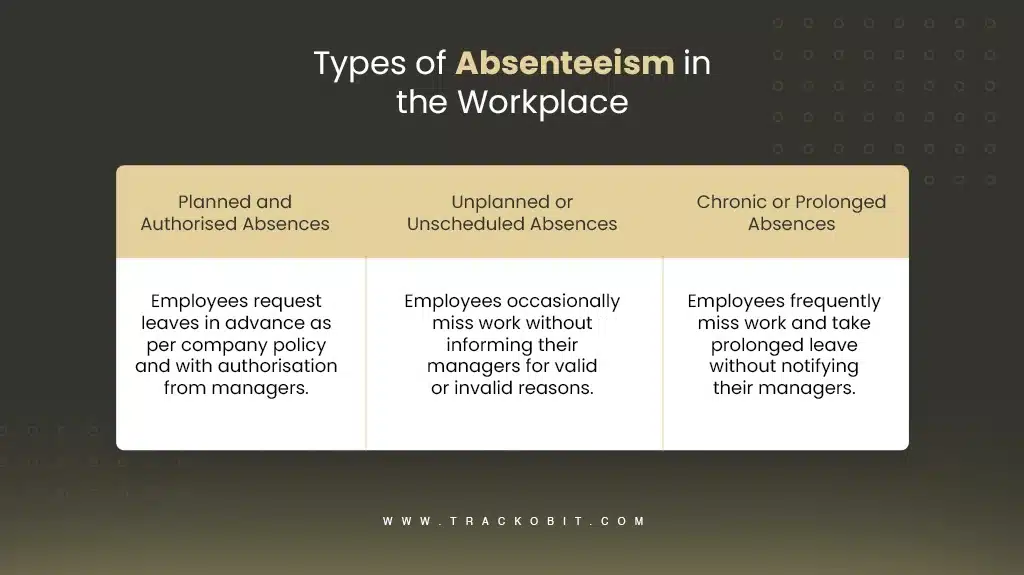
Types of Absenteeism in the Workplace
Category #1: Planned or Approved Absenteeism
This includes all leaves that are scheduled, planned, and approved in advance like:
- Vacation days
- Scheduled medical appointments
- Personal time off
- Work sponsored leisure
Most companies have a field employee attendance policy. It contains the number of assigned leaves and whether advance approval is needed.
For example, the attendance policy of many companies suggests that employees must request leave at least a day in advance.
Category #2: Unplanned, Unscheduled, or Unexpected Absenteeism
Unexpected or unplanned days off typically involve leaves that are not scheduled in advance or pre-approved. Generally, employees take an unplanned leave when there is a physical or mental illness, personal emergency in their homes, or any other unforeseen circumstances.
Imagine, an employee named Rohit wakes up with severe flu symptoms and won’t be able to attend office and hence applies for an impromptu leave. This is an example of unplanned leave as Rohit didn’t anticipate falling ill and scheduled his leave in advance.
Category #3: Excessive or Chronic Absenteeism
In this type, employees take frequent leave without any notice. Strategic Human Resource Management (SHRM) defines it as “two or more occurrences of unexcused absence in a month.”
Employers can also determine this category in their attendance policy. Case Western Reserve University states excessive absences in its attendance policy as follows:
“More than 6 repeated unscheduled absences in 6 months, or 3 incidents of tardiness, or 2 events of partial absences.”
More stats on employee nonattendance:
The cost of absenteeism in the workplace is likely to reach around 2.5% of GDP in Europe. This is per the European Foundation for the Improvement of Living and Working Conditions.
What are the Causes of Absenteeism?
Here are various factors that lead to absenteeism and impact employee engagement and operational productivity.
1. Family Emergencies and Childcare
Employees are often required to take time off to perform their responsibilities as a caregiver. Especially, when they receive family emergencies like childcare, unexpected emergencies, looking after a disabled or elderly family member, etc.
These are genuinely occasional as employees don’t abuse the availability for their time off and utilize it on something that matters. A report titled Caregiving in the US showed that employees spend 23.7 hours each week caring for their family members.
However, they may find balancing family and work responsibilities altogether challenging mainly in the workplace that does not support family-friendly policies. This leads to absenteeism and a drop in the employee productivity.
2. Job Hunting
Employees miss work when they have interviews to attend for new job opportunities. They may also spend their working hours searching for jobs online and submitting resumes. This only results in decreased operational productivity.
Here are some areas of dissatisfaction that influence employees to think of making of switch:
- Job dissatisfaction
- Lack of employee engagement
- Limited scope for growth
- No training programs
- Insufficient compensation
- Lack of rewards & recognition
3. Accidents and Injury
In 2021, BLS showed that accidents and injury are other drivers of absenteeism. They issued a report claiming 2.6 million workplace injuries happened in 2021 alone. Moreover, an Australian study, which is done among 13,582 revealed that high-risk drinkers are more likely to have accidents, illness, and injuries in the workplace.
CDC researched and brought in the main reasons for absenteeism are work-related injuries leading to absenteeism such as:
- Slipping and falling due to slick floors.
- Falling from height while working at the construction site.
- Tripping over debris or trash on stairways.
- Carpal tunnel syndrome occurs due to repetitive motions.
- Electrocution is when workers are exposed to dangerous power lines.
- Getting heat stroke due to working out in extremely hot and humid climates.
Other common factors leading to physical exhaustion and escalating chance of injuries are:
- Prolonged standing/sitting
- Bad posture
- Excessive system noise
- Carrying heavy physical loads
- Poor workplace temperature control
4. Workplace Stress and Burnout
Burnout is the result of workplace stress or negative work culture. It occurs when employees work more excessively to meet targets, often to the detriment of their personal lives and health. They cannot keep a balance between their work and lives. Therein it causes a severe impact of absenteeism on employees’ mental and physical health.
Read Blog – 7 Ways to Improve Your Work-Life Balance
Gallup’s study of 7500 employees is bound to amaze you. It reveals what employees do when feeling overburdened, stressed, and burned out at work.
- 63% of employees prefer a sick leave.
- 23% of employees visit the emergency room.
- 2.6 times they think of leaving their current employer.
- 13% of them show less confidence in their work performance.
All these are caused by poor work culture, but what are the main sources that make a company’s culture negative and poor? Let’s explore.
- Excessive workload
- Lack of enough resources or support
- Limited decision-making power for employees
- Unfair and biased treatment
- Poor communication
- Unclear job expectations and roles
- Lack of job security/ company values
Moreover, researchers at Culture Shift found that 71% of 1,000 workers in the UK took sick leaves to prevent being in contact with a negative coworker. The same report also revealed that 61% of employees applied for prolonged leave to avoid discrimination, harassment, or bullying at their workplace.
5. Mental and Physical Health Issues
According to a report by BLS in January 2022, 7.8 million employees were away from their workplace due to medical problems like injury or illness. Additionally, 4.2 million full-time workers work part-time due to medical problems, appointments, or illness.
Another study demonstrated by the Centers for Disease Control and Prevention (CDC) showed that the top five chronic diseases, leading to absenteeism are:
- Hypertension
- Diabetes
- Obesity
Besides, the World Health Organization (WHO) in its report mentioned that depression and anxiety lead to a loss of 12 billion workdays each year. Also, the American Institute of Stress revealed that 83% of U.S. workers have work-related stress and 1 million workers don’t show up for work due to stress.
That’s not it!
One more study claims that depression alone can lead to lost productivity and cost companies around $44 billion per year. Moreover, 40% of employees have complained that their companies did not provide adequate policies to address mental health issues.
What are the Major Consequences of Absenteeism in the Workplace?
It is true that absenteeism is not good for an organization’s health. But what makes it so influential? And why is it something that companies have to deal with precautions? Let’s learn some major consequences of absenteeism that directly impact the workplace.
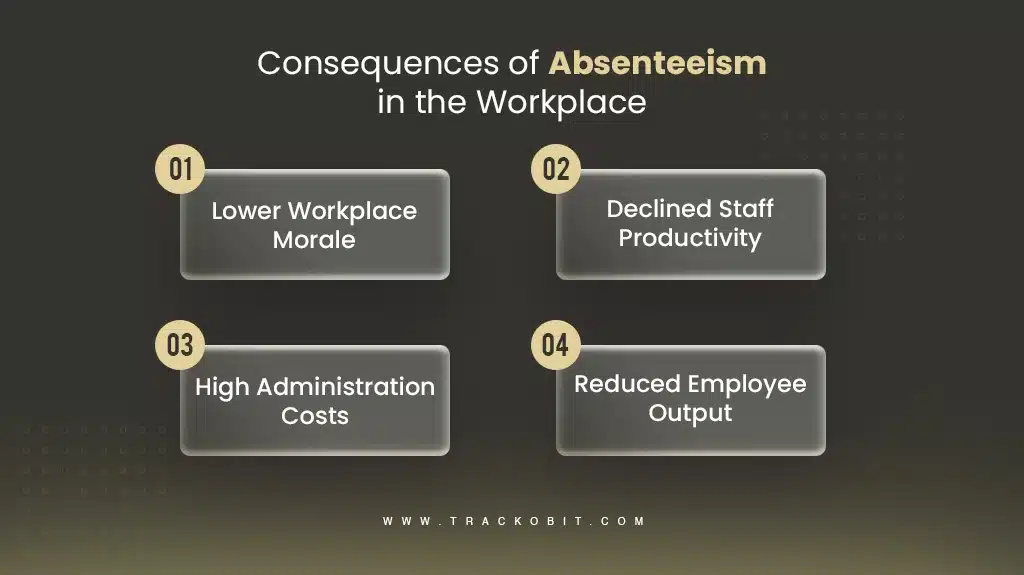
Consequences of Absenteeism
1. Lower Workplace Morale
When employees feel undervalued, underpaid, or overworked, they tend to skip their work schedules. This creates an endless cycle of employee absenteeism and decreased morale. Moreover, it heightens when the company does not care about its employees.
2. Declined Productivity
Usually, companies assign the work not performed by the absent employees to their available workforce. This adds workload and burden to the existing employees. Also, frequent absences lead to a decline in overall productivity as evidenced by the stats, “the Centers for Disease Control and Prevention (CDC) states that absenteeism costs employers $225.8 billion annually in productivity losses.”
Look at the table below to explore more.
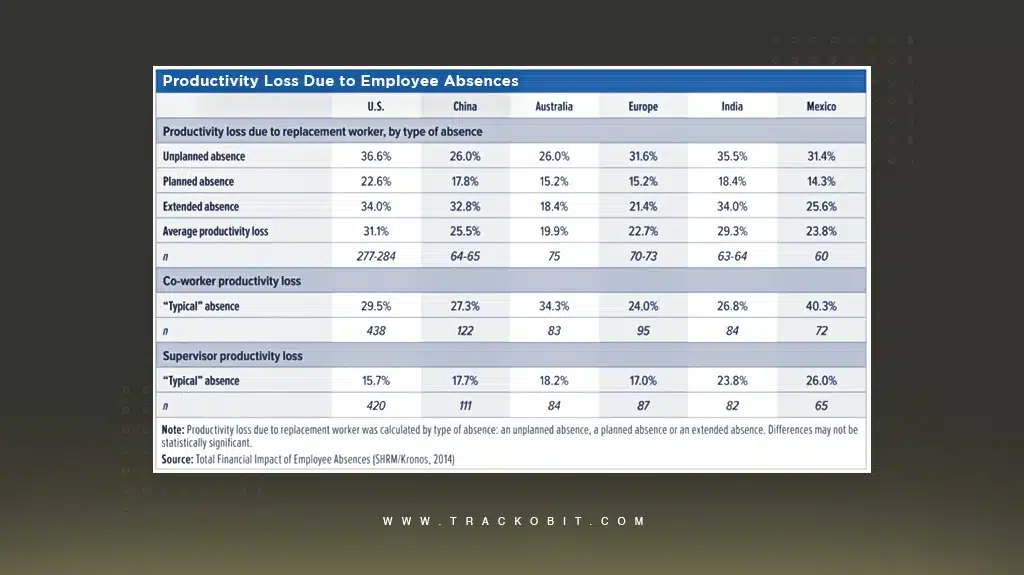
Productivity Loss Due
3. Increased Administration Cost
Companies replace their employees who take repetitive, prolonged, and excessive absences by hiring newer ones. This affects administrative costs, time, and money as they bear the cost of interviewing, hiring, and training their employees. According to a study by Circadian, absenteeism costs employers $3600 per hour per employee each year.
4. Reduced Output
Absenteeism can also disrupt communication and hinder the flow of knowledge transmission for service delivery within teams. For instance, if a manager who is obliged to make job schedules and dispatch their employees, misses the office, all further tasks get affected. Employees may not be present at their supposed task locations and this could lead to suboptimal outcomes. Over time, this could bring a downward spiral affecting the workplace’s ethics and output.
Top Ways to Fix Absenteeism and Improve Workplace Productivity
By now, you know what absenteeism is and its consequences. Now learn how to combat it in the workplace.
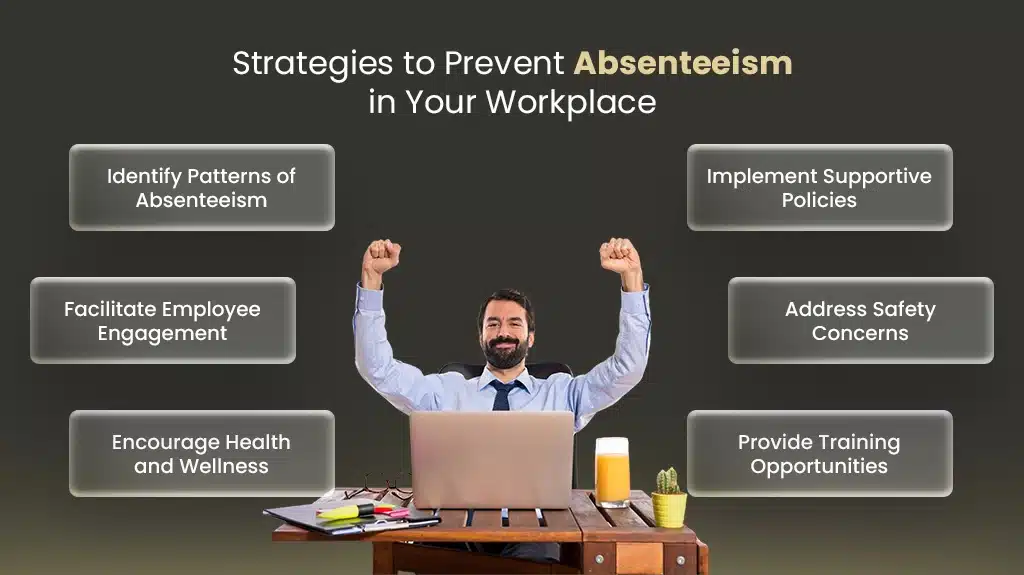
Strategies to Prevent Absenteeism
1. Identify Patterns of Employee Absences
Before addressing the issue of workplace absenteeism, it’s important to identify it first. To do this, you need an advanced solution to record and analyse employees’ work data. Attendance, leaves, and completed work hours are metrics needed to identify employee nonattendance.
Plus, you need all this data consolidated onto a single platform. It’s not workable to juggle between multiple software solutions. That’s why you should choose software like TrackoField. It’s an all-in-one employee tracking solution that can expand as attendance management software.
Using such a software solution, you can gain useful insights into employees’ attendance. The software records staff attendance, leaves, overtime, breaks, late arrivals, early exits, etc.
Analysing these metrics can reveal patterns in employees’ absence on specific days or seasons. Managers can adjust leave policies or shift timings accordingly. You can also put a cap on the leaves.
2. Facilitate Employee Engagement
Employee engagement shapes a positive work environment. Even Dr, John G. Turner in his research paper, mentioned that a work environment where employees are engaged has less absenteeism.
However, not all employees may use the same communication platform to converse about meetings and task-related updates. This leads to a siloed and fragmented workflow. For instance, if one employee is using WhatsApp and the other one is using Skype – it may corrode the processes.
That’s why you must use the best employee monitoring software. The software, being equipped with an in-app communication tool lets you streamline the effective communication between team members. Upon accessing the tool, employees can have real-time conversations on products or task-related inquiries via voice chat. Moreover, they can attach files and documents that need to be verified by managers.
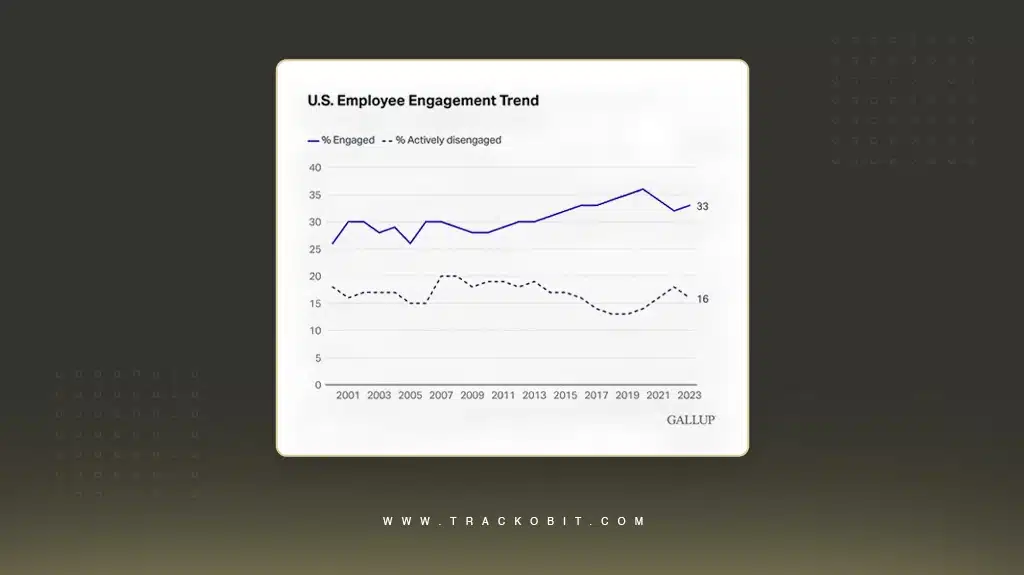
Employee Engagement Trend
3. Encourage Health and Wellness
Work stress often leads to the risk of chronic diseases, affecting employees’ health and wellness. So, try implementing some wellness programs that address employees’ well-being. Besides, you can adjust your employees’ job schedules in a way that doesn’t choke their bandwidth or set it during hours when the temperature isn’t too intense to bear. This will prevent your employees from being exposed to heat waves and stay protected.
However, on-the-spot changes with manual scheduling seem challenging. So, you must switch to our smart field job scheduling software. The software is designed to simplify the job scheduling procedure with its in-built templates. The cloud-based platform also synchronizes with employee time-tracking software, letting managers assess employee availability and time-off requests. Therein, it enables them to add and amend schedules for their employees easily.
4. Implement Supportive Policies
As previously mentioned, employees take urgent leave due to unforeseen circumstances, maybe like family emergencies. So, try to implement a work-family and supportive policy. This will provide your employees with the adequate support they need while conducting their caregiving duties. This makes them feel valued and thus prevents absenteeism.
However, don’t overburden yourself while using spreadsheets to amend the entire leave policies. Just, use the best leave management software that covers:
- Instant leave application and approval process
- Leave policy setup
- Leave transactions tracking
- Leave summary report
With the software in place, you can also specify no. of leaves, types of leaves, and each employee’s leave balance in a few clicks. Looking for one such software that provides the benefit of policy enforcement? Try TrackoField for free and streamline the leave management process with its:
- Admin software for HR managers
- Leave portal app for employees’ self-service
5. Address Safety Concerns
Employees show up more actively in jobs where their safety and well-being are recognised and valued. Any moment when they feel their safety is compromised and there are a series of fatal events while working in risky sites, this can trigger their constant absences.
Therefore, panic or SOS buttons are a crucial tool in ensuring workplace safety. These buttons are built into field service mobile apps like TrackoField. When activated, the button sends a distress signal to field managers, notifying them about the emergency.
SOS buttons allow responders to locate the exact location of the distress signal and employees. Very helpful for industries whose employees operate on-field as service technicians, medical or sales reps., or labor in risky construction or mining sites.
This proactive approach may look small, but you cannot imagine how deeply this will make your employees feel valued and cared for.
6. Provide Training Opportunities
Training programs can be a great morale booster in an organisation. They help employees expand their skills and take on more responsibilities at work.
Ask yourself. Would you prefer to work in a company with no career growth?
No, right? It’s important to grow and improve your skills. Otherwise, employees succumb to stagnancy and lose interest in work. Plus, training employees imparts a sense of commitment and loyalty to them.
But first, you need to identify the skill gaps in your organisation. Employees may need different types of training. Wondering how to achieve this? Well, worry not! Field employee tracking software is here to help.
It tracks your staff in real-time and monitors all their activities. The software also records and archives employees’ data securely. You can generate task completion rates and performance reports. Thus, you can identify which technicians need training and which don’t.
How Can TrackoField Help You Reduce Absenteeism?
TrackoField boasts several advanced features like time tracking and live location monitoring to reduce absenteeism. Let’s take a look at how they keep absenteeism in check.
1. Real-time employee tracking
This feature gives you a complete insight into your employees’ activity. You can check their live location, task progress, and timeline for each completed task. This lets you identify which employees are actively participating in the assigned tasks. You can also check their unscheduled stops, missed deadlines, and late arrivals.
2. Robust attendance and leave management system
This is yet another feature that you can streamline to sail against the storm of absenteeism smoothly. Being equipped with geocoded attendance marking, the feature lets you prevent buddy punching, extended breaks, and time theft. Thus, warding off employees from being absent from their duties. Also, it has a flexible leave management module consisting of reliable data on employees’ leaves. Managers, upon analyzing the data can detect employees with higher leave rates. Consequently, you can take appropriate actions to stop them from taking the next leaves.
3. Optimal Job and Task Scheduling
TrackoField lets you optimally plan, create, and assign tasks to your employees. The software gives you an overview of your entire workforce. This can help you:
- Distribute tasks to each employee fairly.
- Reduce scheduling conflicts.
- Assign shifts and tasks to employees based on availability and client proximity.
- Use predefined shift templates to prevent repeat work.
To sum up, TrackoField ensures the right employee is assigned the right work at the right time.
To Sum it Up!
We’ve covered everything you need to know about what is absenteeism, causes & best ways to deal with it. It doesn’t matter what industry you belong to. If you manage a field workforce, you need accurate employee monitoring software.
It can reduce the nonattendance of employees and track their time with precision. You no longer have to suffer the consequences of chronic unexplained employee absences.
So, without further ado, say goodbye to lost revenue and poor employee productivity. Get in touch with experts at TrackoField to learn more.
FAQs
-
What are the causes of absenteeism?
Many factors drive employees to take unexplained and long time off from work. These include family emergencies, childcare, job hunting, accidents or injuries, stress, and burnouts.
-
What are the strategies to deal with absenteeism?
Implementing these strategies will help you reduce employee absences at work: - Encourage health and wellness - Add supportive policies - Address safety concerns - Facilitate employee engagement - Providing training opportunities - Identify patterns of employee absences
-
What is the impact of absenteeism?
Absenteeism can impact your business in a lot of ways. However, the most common impacts are reduced output, increased administration costs, lower workplace morale, and declined productivity.
Shivani is a Content Specialist working for TrackoField. She comes with years of experience writing, editing and reviewing content for software products. Her underlining expertise in SaaS especially H... Read More
Related Blogs
-

How MFIs Are Working In Modern Day Scenario? A Complete Breakdown
Mudit Chhikara December 30, 2025How field force automation is helping MFIs transform field operations.
-

Unified Field Workforce Dashboard: Monitor Tasks, Attendance & More In One Place
Mudit Chhikara December 15, 2025Bring full clarity to field operations with a single, real-time field workforce dashboard.
-

Loan Disbursement in NBFCs: From 15 Days to 3 Minutes – Learn How
Shemanti Ghosh December 11, 2025TrackoField’s AI-enabled field force automation software speeds up loan disbursals in NBFC with field agent task monitoring and facial attendance…
-

AI Facial Recognition Attendance: A Game-Changer for Fraud-Free Field Operations
Mudit Chhikara December 9, 2025Ensure transparent attendance and eliminate fraud before it even starts with AI facial recognition and geofencing.

Subscribe for weekly strategies to boost field team productivity.
Your inbox awaits a welcome email. Stay tuned for the latest blog updates & expert insights.
"While you're here, dive into some more reads or grab quick bites from our social platforms!"Stay Updated on tech, telematics and mobility. Don't miss out on the latest in the industry.
We use cookies to enhance and personalize your browsing experience. By continuing to use our website, you agree to our Privacy Policy.


































